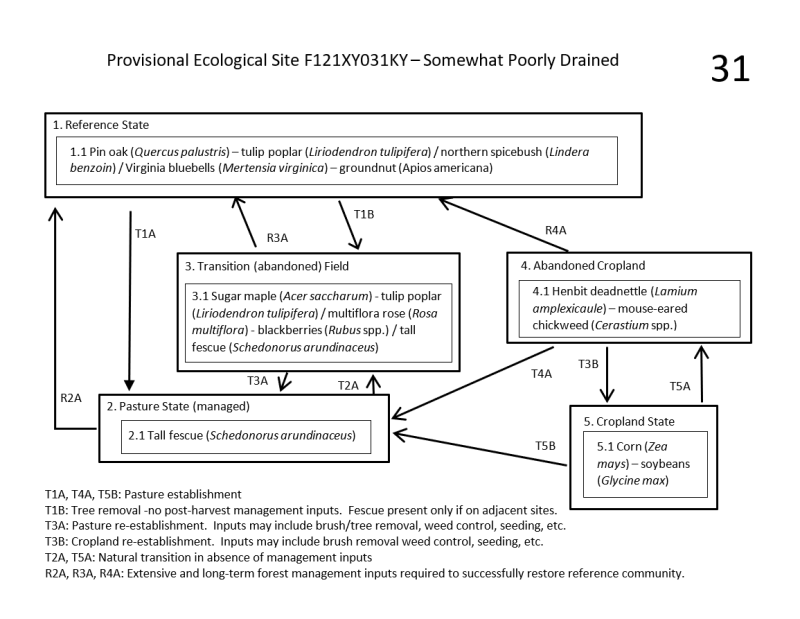
Natural Resources
Conservation Service
Ecological site F121XY031KY
Somewhat Poorly Drained Floodplain
Last updated: 10/01/2024
Accessed: 12/22/2025
General information
Provisional. A provisional ecological site description has undergone quality control and quality assurance review. It contains a working state and transition model and enough information to identify the ecological site.
MLRA notes
Major Land Resource Area (MLRA): 121X–Kentucky Bluegrass
The Somewhat Poorly Drained Floodplain ecological site
General: MLRA 121 is in Kentucky (83 percent), southern Ohio (11 percent), and southern Indiana (6 percent). It makes up about 10,680 square miles (27,670 square kilometers). The cities of Cincinnati, Ohio, and Louisville, Frankfort, and Lexington, Kentucky, are in this area.
Physiography: This area is primarily in the Lexington Plain Section of the Interior Low Plateaus Province of the Interior Plains.
Soils: The dominant soil orders in MLRA 121 are Alfisols, Inceptisols, and Mollisols. The soils in the area dominantly have a mesic soil temperature regime, an udic soil moisture regime, and mixed mineralogy. They are shallow to very deep, generally well-drained, and loamy or clayey. Hapludalfs formed in residuum on hills and ridges (Beasley, Cynthiana, Eden, Faywood, Lowell, and McAfee series) and in loess over residuum on hills and ridges (Carmel and Shelbyville series). Paleudalfs (Crider and Maury series) formed in loess or other silty sediments over residuum on hills and ridges. Fragiudalfs (Nicholson series) formed in loess over residuum on ridges. Hapludolls formed in residuum on hills and ridges (Fairmount series) and in alluvium on floodplains (Huntington series). Eutrudepts (Nolin series) formed in alluvium on flood plains.
Geology: Most of this area has an Ordovician-age limestone that has been brought to the surface in the Jessamine Dome, a high part of a much larger structure called the Cincinnati Arch. The strata of limestone have a propensity to form caves and karst topography. Younger units of thin-bedded shale, siltstone, and limestone occur at the eastern and western edges of the area.
The area has no coal-bearing units. Pleistocene-age loess deposits cover most of the bedrock units in this MLRA, and some glacial lake sediments are at the surface in the northwest corner of the area. Unconsolidated alluvium is deposited in the river valleys.
Classification relationships
Bottomland hardwood forest (Kentucky State Nature Preserves Commission, 2009)
Ecological site concept
The Somewhat Poorly Drained Floodplain ecological site occurs on floodplain soils. Representative soils include: Newark, Rahm.
The natural vegetation of these sites will vary in relationship to the setting, patterns of drainage, disturbances, and previous vegetation communities. Future field work may result in multiple ESDs from this initial PES grouping due to flooding frequency and/or ponding duration. Most of these sites within MLRA 121 are now drained and being utilized for agricultural purposes.
State 1. (Reference): Provisional Ecological Site (PES)
State 1, Phase 1.1: Plant species dominants:
Quercus palustris - Liquidambar styraciflua /Lindera benzoin /Mertensia virginica-Apois americana
(pin oak-sweetgum/ spicebush /Virginia bluebells-groundnut)
Narrative: Trees found on these sites as listed in the National Soil Information System (NASIS) included pin oak, sweetgum, tuliptree, eastern cottonwood, green ash, white ash, red maple, cherrybark oak, northern red oak, and black oak. Understory species may include dogwood, pawpaw, arrowwood (Viburnum dentatum), and witchhazel (Hamamelis virginiana).
State: 2. Pasture
State 2, Phase 2.1: Managed Pasture. Plant species dominants: Schedonorus arundinaceus (tall fescue)
State: 3 – Transitional (Abandoned) Field
State 3, Phases 3.1: Acer saccharinum-Liriodendron tulipifera/Rosa multiflora- Rubus spp. /Schedonorus arundinaceus (sugar maple - tulip poplar / multiflora rose – blackberry / tall fescue)
State: 4. Abandoned cropland
State 4, Phase 4.1: Plant species dominants: Lamium amplexicaule - Cerastium L.
(henbit deadnettle - mouse-eared chickweed)
State: 5. Cropland
State 5, Phase 5.1: Plant species dominants: Zea spp. – Glycine spp.
Plants on these sites will be dependent upon seeding and management. Most common crops are corn and soybeans. Due to the drainage issues on these soil, many have been tiled extensively to facilitate crop production.
Restoration of these non-forested states to the reference forest community would require substantial and long-term inputs including planting, timber stand improvement practices, and weed control.
Associated sites
| F121XY030KY |
Poorly Drained & Very Poorly Drained Floodplain Poorly drained and Very Poorly Drained Floodplains |
|---|---|
| F121XY033KY |
Well Drained & Moderately Well Drained Floodplain Well Drained and Moderately Well Drained Floodplain |
Table 1. Dominant plant species
| Tree |
(1) Quercus palustris |
|---|---|
| Shrub |
(1) Lindera benzoin |
| Herbaceous |
(1) Mertensia virginica |
Click on box and path labels to scroll to the respective text.
